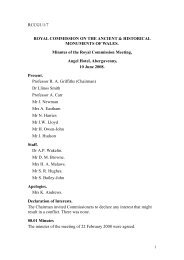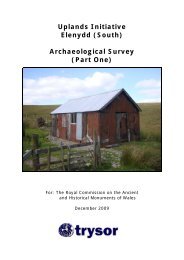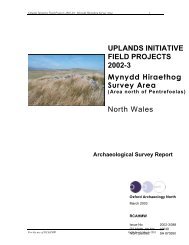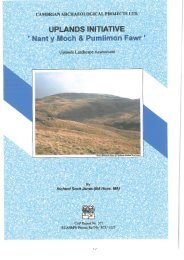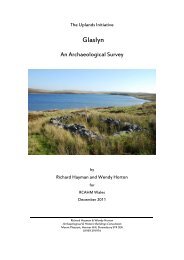Arenig Fawr, Merioneth - Royal Commission on the Ancient and ...
Arenig Fawr, Merioneth - Royal Commission on the Ancient and ...
Arenig Fawr, Merioneth - Royal Commission on the Ancient and ...
You also want an ePaper? Increase the reach of your titles
YUMPU automatically turns print PDFs into web optimized ePapers that Google loves.
entrance to an underground level (nprn 511227), which has been exposed in <strong>on</strong>e place<br />
where a pit has collapsed (nprn 511231) (fig 18). Ano<strong>the</strong>r, large backfilled pit (nprn<br />
511197) was probably ano<strong>the</strong>r, perhaps a shaft, as a path (nprn 511198) leads from it<br />
to a large ore bin or dressing floor (nprn 511200). (The l<strong>and</strong>owner has said that<br />
underground workings were disturbed when a modern vehicle track was created.)<br />
O<strong>the</strong>r ore bins were found scattered across <strong>the</strong> hill, close to large opencast workings<br />
(nprn 511219, 511229, 511242) (fig 19).<br />
There are few visible remains of manganese mining at Pistyll Gwyn, where output may<br />
never have been substantial. There are no Crown Grants that menti<strong>on</strong> Pistyll Gwyn,<br />
although according to Edward Halse, mine agent at Mynydd Nodol, manganese was<br />
worked in <strong>the</strong> 1870s from a vein 4-5 feet wide (1.2-1.5m), with a 77.5-degree dip<br />
(Down 1980, 51). Several small surface workings have been identified (nprn 510834-<br />
510839), some of which may have been prospecting trenches, <strong>and</strong> a possible ore bin<br />
(nprn 510840). Any underground workings have been obscured by backfill.<br />
O<strong>the</strong>r Industries<br />
Llyn <str<strong>on</strong>g>Arenig</str<strong>on</strong>g> <str<strong>on</strong>g>Fawr</str<strong>on</strong>g> was adapted as a reservoir from 1830 by <strong>the</strong> Bala Water Works<br />
Company. The dam was altered in 1864, but was altered again in <strong>the</strong> twentieth century<br />
<strong>and</strong> is now of modern character (nprn 510707). The first pipeline was laid in 1879, but<br />
<strong>the</strong> lines of two pipes can be traced <strong>on</strong> <strong>the</strong> ground (nprn 510698, 510699), leading to a<br />
treatment works at Ty’n-y-cae (bey<strong>on</strong>d <strong>the</strong> survey area) (Roberts 1995, 13).<br />
There are comparatively few quarry sites within <strong>the</strong> survey area. Ample quantities of<br />
field st<strong>on</strong>e were sufficient for local building needs. Slate quarries bel<strong>on</strong>g to <strong>the</strong> late<br />
nineteenth <strong>and</strong> <strong>the</strong> twentieth centuries, hoping to exploit <strong>the</strong> established market for<br />
roofing slates. They are c<strong>on</strong>fined to <strong>the</strong> small areas where shale overlies igneous rocks<br />
(nprn 510972, 510910). A quarry was begun <strong>on</strong> Ffridd y Gloddfa (nprn 510910),<br />
probably in <strong>the</strong> early twentieth century. However it was quickly ab<strong>and</strong><strong>on</strong>ed because it<br />
did not yield slates of sufficient quality.<br />
Opportunities for quarrying were increased after <strong>the</strong> Bala & Ffestiniog Railway was<br />
built, a small secti<strong>on</strong> of which passed across <strong>the</strong> survey area. The railway was opened in<br />
1882 <strong>and</strong> closed for traffic in 1961 – <strong>the</strong> immediate cause of its closure was <strong>the</strong><br />
flooding of part of <strong>the</strong> line to create Llyn Celyn reservoir. Granite quarrying near <strong>the</strong><br />
railway began in <strong>the</strong> last decade of <strong>the</strong> nineteenth century at Maen Grugog (nprn<br />
511002) <strong>and</strong> at Clogwyn y Fran. The latter was massively extended in <strong>the</strong> twentieth<br />
century <strong>and</strong> was excluded from <strong>the</strong> survey area (but see an outlying working, nprn<br />
511246), although it is <strong>the</strong> largest of <strong>the</strong> <str<strong>on</strong>g>Arenig</str<strong>on</strong>g> Quarries. It was linked by tramroad<br />
(nprn 510953) with ano<strong>the</strong>r twentieth-century quarry site (nprn 510972), which was<br />
extended over <strong>the</strong> road to <strong>the</strong> railway near <str<strong>on</strong>g>Arenig</str<strong>on</strong>g> Stati<strong>on</strong>. Electricity for <strong>the</strong>se quarries<br />
was provided by a generating stati<strong>on</strong> (nprn 510956), which st<strong>and</strong>s close to <strong>the</strong><br />
tramroad. The brick building is now roofless <strong>and</strong> its walls are in a precarious c<strong>on</strong>diti<strong>on</strong>.<br />
No machinery survives, but a narrow wheelpit outside <strong>the</strong> building suggests that power<br />
for <strong>the</strong> generator was provided by a double Pelt<strong>on</strong> wheel. This was supplied by a<br />
pipeline, of which st<strong>on</strong>e piers survive (nprn 510957), <strong>and</strong> fed from two reservoirs (nprn<br />
510958, 510959), <strong>on</strong>e of which retains water. Quarrying here appears to have<br />
outlasted <strong>the</strong> closure of <strong>the</strong> railway.<br />
23




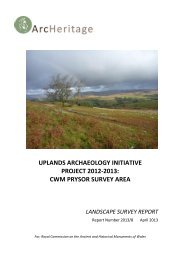




![The Source of the Usk Walk [2012 PDF]](https://img.yumpu.com/49285699/1/190x245/the-source-of-the-usk-walk-2012-pdf.jpg?quality=85)


